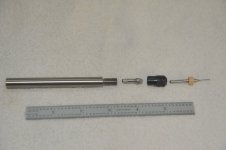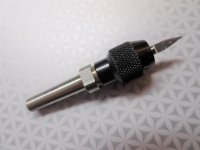rons
Diamond
- Joined
- Mar 5, 2009
- Location
- California, USA
That's what I'm calling the partial thread at the right and left sides.
The left side is always worse when there is a shoulder that is deeper than the thread depth.
How do you trim the shark fin off. The fin is so thin it bends easily and would break off eventually.
I use a small file with micro pliers. Is there a better way other than applying for a loan to get a CNC lathe?

The left side is always worse when there is a shoulder that is deeper than the thread depth.
How do you trim the shark fin off. The fin is so thin it bends easily and would break off eventually.
I use a small file with micro pliers. Is there a better way other than applying for a loan to get a CNC lathe?






